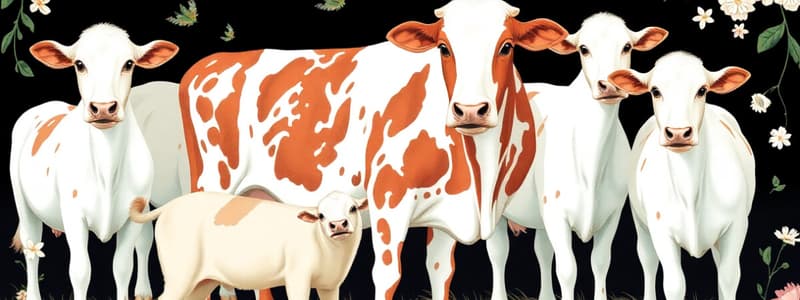Podcast
Questions and Answers
What is one of the main aims of the UK dairy industry?
What is one of the main aims of the UK dairy industry?
- To produce milk of any quality
- To reduce the cost of dairy products
- To increase the number of dairy farms
- To produce profitable milk from healthy cows (correct)
The number of dairy farms in the UK has increased by 45% over the past 20 years.
The number of dairy farms in the UK has increased by 45% over the past 20 years.
False (B)
What formula represents the profit in the dairy industry?
What formula represents the profit in the dairy industry?
Profit = Production x Price – Costs
The average cost of heifer rearing is approximately _____?
The average cost of heifer rearing is approximately _____?
Match the following aspects of dairy management with their descriptions:
Match the following aspects of dairy management with their descriptions:
What are farmers primarily paid for in the dairy industry?
What are farmers primarily paid for in the dairy industry?
Cows in a dairy farm can be categorized as either lactating or dry.
Cows in a dairy farm can be categorized as either lactating or dry.
What is the purpose of pasteurization in the milk supply chain?
What is the purpose of pasteurization in the milk supply chain?
The typical water requirement is _____ litres of water for 1 litre of milk.
The typical water requirement is _____ litres of water for 1 litre of milk.
Match the following welfare regulations with their focus area:
Match the following welfare regulations with their focus area:
Which type of milking system allows cows to milk themselves?
Which type of milking system allows cows to milk themselves?
Farmers are not responsible for ensuring the health and welfare of their animals.
Farmers are not responsible for ensuring the health and welfare of their animals.
What is the average weight of feces produced by dairy cattle per day?
What is the average weight of feces produced by dairy cattle per day?
A calf must not be confined in an individual pen after _____ weeks of age.
A calf must not be confined in an individual pen after _____ weeks of age.
What is the primary concern associated with nitrogen and phosphorus used in fertilizers?
What is the primary concern associated with nitrogen and phosphorus used in fertilizers?
Flashcards
What's the goal of the UK dairy industry?
What's the goal of the UK dairy industry?
The UK dairy industry's main aim is to produce milk that meets safety standards, comes from healthy cows, and ensures high animal welfare. This means prioritizing both profitability and responsible practices.
Dairy farm trends in the UK
Dairy farm trends in the UK
The dairy industry in the UK has experienced a significant reduction in farm numbers over the past 20 years, with a 45% decline. This means fewer farms are managing larger herds and producing more milk per cow.
Factors influencing dairy farm profit
Factors influencing dairy farm profit
Profitability in the dairy industry is determined by several factors like the quantity and quality of milk produced, animal health and welfare, feed management, and overall efficiency.
Milk solids and their importance
Milk solids and their importance
Signup and view all the flashcards
Cost of rearing a heifer
Cost of rearing a heifer
Signup and view all the flashcards
Milk Payment Factors
Milk Payment Factors
Signup and view all the flashcards
Somatic Cell Count
Somatic Cell Count
Signup and view all the flashcards
Bacteria Count in Milk
Bacteria Count in Milk
Signup and view all the flashcards
Replacement Heifers
Replacement Heifers
Signup and view all the flashcards
Milking Parlor
Milking Parlor
Signup and view all the flashcards
Robotic Milking
Robotic Milking
Signup and view all the flashcards
Milking Systems
Milking Systems
Signup and view all the flashcards
Block Calving System
Block Calving System
Signup and view all the flashcards
Dairy Farm Effluent Management
Dairy Farm Effluent Management
Signup and view all the flashcards
UK Welfare Regulations for Dairy Animals
UK Welfare Regulations for Dairy Animals
Signup and view all the flashcards
Study Notes
UK Dairy Industry Overview
- The UK dairy industry aims to produce profitable milk from healthy cows raised under high welfare standards.
- Key profit drivers include breeding, milk quality, welfare, biosecurity, nutrition, stockmanship, calf rearing, and heifer rearing.
- In 2022/23, the milk supply was 14.2 billion litres, with liquid milk accounting for 43%.
- There are 7,500 dairy producers, with a milking herd of 1.63 million cows averaging 7,580 litres per year.
- This results in 12.4 billion litres of milk produced per year.
- Milk utilisation in 2022/23 included 43% liquid milk, 35% cheese, 37% butter, and 32% milk powders, and other dairy products.
UK Milk Flow Diagram (2022)
- 15,088 million litres of milk are produced.
- 14,857 million litres are delivered to dairies.
- 91 million litres are processed on farms.
- 14,949 million litres are available for human consumption.
- 14,242 million litres are in supply.
- 885 million litres are raw milk exports.
- 7,944 million litres are used in manufacturing.
- 282 million litres represent stock change and wastage.
- 177 million litres represent imports.
- 6,016 million litres are for liquid consumption.
UK Dairy Farms (1995-2022)
- The number of dairy farms in the UK has decreased by 45% over the past 20 years.
GB Producer Numbers & Volume per Farm (Feb-19 to Apr-23)
- GB dairy farm numbers have fluctuated (shown in a graph) between 7,500 to 8,500.
- The average volume per producer has risen slightly (shown in a graph)
UK Milking Herd (24 Months+ who have Calved)
- The UK's milking herd has fluctuated (shown in a graph) over the past years.
Average UK Dairy Herd Size & Milk Yield (1998/99 to 2022/23)
- UK average dairy herd size and milk yield have shown fluctuating trends (shown in a graph).
Strategically Important Drivers of Profit in UK Dairy
- Factors include breeding, milk quality (aligned to milk buyers' standards - solids vs volume), welfare, biosecurity, nutritional management, stockmanship, calf rearing, and heifer rearing.
- Profit is derived by multiplying production by price, and subtracting fixed and variable costs.
Average Milk Prices (Jul-23 to Jun-24)
- Price per litre (ppl) fluctuates.
- Milk prices (based on GB 5-yr rolling average, excl alignments) have shown gains or losses (as indicated in figures).
- The actual milk/feed price ratio has also shown variations.
UK Dairy Economic Margins (2018-19)
- Profits vary based on whether a farm is all-year-round, autumn-block, or spring-block.
- Top 25% of farms have high margins.
- There is a loss within the middle 50%, and lowest margins within the 25% cohort.
Dairy Cattle Prices (Aug-23, Jul-23, Aug-22)
- Prices for cows (under 36 months, over 36 months), calves (Holstein Friesian (x)) and bulls vary (shown in a graph) with fluctuation by month and year.
How Dairy Farmers Get Paid
- Farmers get paid based on volume, solids (including fat and protein which fluctuate according to milk quality), and milk quality. Quality factors include somatic cell counts, and bacteria counts, indicating udder health and hygiene.
Farm to Fridge Milk Supply Chain
- The process involves milking, cooling, transportation, quality control, processing, and pasteurization.
Types of Dairy Animals
- Calves (heifers and bull calves)
- Replacement heifers
- Bulls
- Cows (Dry and lactating).
Types of Dairy Systems
- Extensive Grass-based
- Intensive housed systems
- Combination systems
- Block calving (spring, autumn dual) vs. all-year round
Key Performance Indicators (KPIs)
- The presented KPIs for dairy farms include processes (standard procedures and best practice) and outcome metrics (e.g., calves reared).
- Targets are included (e.g., calf mortality rates.)
Summary of Key Performance Indicators (500 NMR milk recording herds ending August 2019)
- This section includes detailed data, categorized into different parameters like the culling rate, percentage culled, age at exiting the herd and age at exit by lactation, percentage served by days 80, etc.
Environmental and Resource Issues
- Effluent management (faeces, urine, water usage) is one key aspect impacting the environmental issues
- Carbon footprint is derived from methane, nitrogen oxide, nitrogen(fertilizer) and phosphorus (fertiliser)
Feed Conversion Ratios (Various Livestock)
- Feed conversion ratios for various farmed livestock (cows milk, goats milk, farmed BC salmon, broiler chickens, etc) are presented on a graph for live weight.
Welfare Regulations (DEFRA)
- The laws pertain to general welfare, the Welfare of Farmed Animals (England) 2000 (freedoms), the Protection of Animals Act 1911-2000 and the Welfare of Farmed Animals Regulations (2000), and specific regulations for animals' transport, veterinary procedures and anaesthetics.
Studying That Suits You
Use AI to generate personalized quizzes and flashcards to suit your learning preferences.




